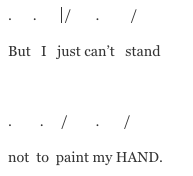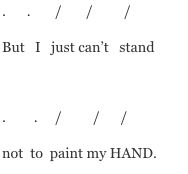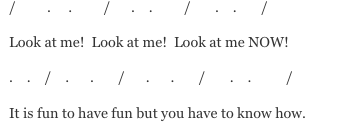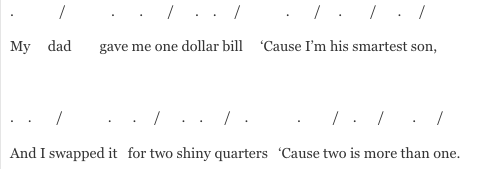Today, let’s see how my academic background applies to writing, analyzing, and revising your rhyme. Maybe something will click with you. “Oh—that’s why this line doesn’t work.” Analyze your own manuscript. Do you think you maybe need to revise your rhyme once more, before paying for editor? Don’t waste money paying an editor when your rhyme is so bad that you’ll need so much work that it will change your voice. Here are just a few of things a linguist studies…
Prosody – In linguistic analysis, you look at the rises and falls of speech, and the stress. When you talk and read to young children, your voice exaggerates this prosody. This is sometimes called “maternal speech” or “parent-infant” speech. Scholars have been studying it, and the effect that it has on children acquiring language, for decades. Here’s an example of me talking to my own daughter, Sequoia, in 2008, when she was learning the alphabet phonetically. I’ve removed privacy on the video so you can see how my voice sounds different from how I would speak to an adult (at least, we would hope so). I address her with her nickname, Skiki.
https://youtu.be/Inp_vcPvFjA
Prosody overlaps with intonation, which is a word you might be more familiar with. Prosody is also the term for the patterns of rhythm and sound in poetry.
You can’t talk about prosody without talking about…
Stress
When you study phonology and prosody, you study stress. Stress comes naturally within words and sentences. In American English, we have one type of fixed stress that is used to distinguish between a verb and a noun (reCORD/REcord, inCREASE/INcrease, reFUND/REfund, etc.). Stress can also be used to make words stand out within sentences (“I want to know WHY you’re going, not WHEN you’re going.”)
Why does stress matter to us here? Because it affects rhythm. Stress (which I’ll talk about now) is even more important than syllable count (which I’ll talk about in a moment).
Here are some examples of the importance of stress. I’m not going to bore you with words like “iambic” and “anapest,” and I’m not presenting a ton of patterns here, but you can check out these examples and then write out your own lines to look for a pattern. If there’s no pattern at all, you might want to reexamine your rhythm. It should be noted here that yes, different people can produce different stresses when reading your work. Sometimes, though, people don’t recognize stress when it isn’t emphasized with volume, length, or pitch. They don’t know which syllables they’re stressing until they slow down and pay attention to it.
Here’s a line from Karen Beaumont’s “I Ain’t Gonna Paint No More!”
“But I just can’t stand
Not to paint my…HAND!”
How does the stress work here? I’m going to use dots for unstressed syllables and slashes for stressed syllables.

Here, yes, the syllable counts match, but more importantly, the stress matches. This is the author’s rhythm for the main rhyming scheme throughout the book.
Even if you read the lines with a little different stress, you’re likely still following a matching pattern. For example, this would also work for me:

Now let’s look at stress in Dr. Seuss’ “The Cat in the Hat.”
“’Look at me!
Look at me!
Look at me NOW!
It is fun to have fun
But you have to know how.’”
Where is the stress?

See the consistent pattern of / . . ?
Let’s look at one more: “Smart,” from Shel Silverstein’s “Where the Sidewalk Ends” –
“My dad gave me one dollar bill
‘Cause I’m his smartest son,
And I swapped it for two shiny quarters
‘Cause two is more than one.

See the pattern? You might be wondering about that extra dot in line 2. As you read it aloud, not only is there very little stress on both of the words, but they run together, and might naturally be read as one syllable, “niy.”
So, rhythm involves stress as well as…
Syllable count – Obviously, when you build the lines of your rhyme, syllable count matters. That said, you can’t just count the syllables of each word in each line, and then BOOM, you’ve got a good rhythm. You need to pay attention to the stress we just talked about. And while some parents and teachers will read a book very slowly and deliberately, many people will read aloud in a manner that resembles their normal speech patterns. That means that entire syllables might get swallowed, like I mentioned with “niy.” A word might turn into a contraction even when the word is not written as a contraction on the page, perhaps “it is” > “it’s” even when the contraction isn’t written. The point is, rhythm isn’t as simple as counting syllables. In fact, my examples here are of how syllable count does not match. That’s when we go back to examining stress.
Here’s an example of changing syllable count, from Dr. Seuss’s ABC:
line syllable count
“Big A little a What begins with A? 10
Aunt Annie’s alligator……..A..a..A 10
Big B little B What begins with B? 10
Barber baby bubbles and a bumblebee. 11
Big C little c What begins with C? 10
Camel on the ceiling C….c….C” 9
As you can see, Dr. Seuss matched syllable count in his first two stanzas, with 10 syllables per line. Although he subsequently maintains 10 syllables for the first line in his two-line stanzas, the second line varies in syllable count. The biggest change comes with C, but it works.
If you set that excerpt to beats of four (recognizing that I’m annoyingly starting with the thump, to make the thumps line up more clearly), you’d get
Big A little a What begins with A?
THUMP THUMP THUMP THUMP
Aunt Annie’s alli- gator…….. A.. a.. A
THUMP THUMP THUMP THUMP
Big B little b What begins with B?
THUMP THUMP THUMP THUMP
Barber baby bubbles and a bum- ble- bee.
THUMP THUMP THUMP THUMP
Big C little c What begins with C?
THUMP THUMP THUMP THUMP
Camel on the ceiling C…. c…. C
THUMP THUMP THUMP THUMP
In other words, the rhythm is consistent even though the syllable counts don’t match.
Revisiting “Smart,” from “Where the Sidewalk Ends” –
Line syllable count
“My dad gave me one dollar bill 8
‘Cause I’m his smartest son, 6
And I swapped it for two shiny quarters 10
‘Cause two is more than one. 6
And then I took the quarters 7
And traded them to Lou 6
For three dimes—I guess he don’t know 8
That three is more than two!” 6
The second and fourth lines of each stanza each have six (6) syllables. However, the syllable counts of the first and third lines don’t match one another in the first stanza, nor do they match the next stanza’s first and third lines. This is the opposite of the “ABC” example.
We’ve looked at syllable counts as they apply to entire lines, but we also have to consider the syllable count in individual words. There are a number of words in American English that sound different in different regions (such as the common example of ‘aunt’). But this also happens with syllable count. Is towel one syllable or two for you? How about tour? Depending upon where you’re from, these words could be one syllable or two; will your reader be from the same region as you?
Another mistake that people often make if they’re just counting syllables, is that they count syllables when the words are pronounced carefully, as opposed to naturally. An example that I found when reviewing Pillow Parade, was the word ‘toward’. The author was counting ‘toward’ as a two-syllable word (təˈwɔrd), but it’s pronounced by most American English speakers as “toard” (tôrd). This was throwing off the rhyme that he had originally written.
This leads us to…
Regional Dialect
Aunt is arguably the most well-known English word with two distinct and non-rhyming pronunciations in the US: rhyming with “ant” (which it does for me) or rhyming with “ahnt” (which it does for my husband). But it doesn’t end there.
In some of the long-established cities of the Northeast alone, accents can vary wildly. Boston English does not sound like Philly speak. The English of New York City does not sound like the English of western New York. Sure, some pronunciations overlap, but many of the dialects’ distinct features will not rhyme. All over the US, we have regional dialects that don’t match one another—Southern English, the English of Minnesota, and elsewhere.
I come from Philadelphia, where there is an issue with the vowel æ, which is the vowel in words like at (æt) and cat (kæt). For most Americans, pronunciation of that vowel follows distinct patterns. In Philly, however, we have an anomaly. Three words that end in -ad [æd] do not rhyme with the rest of the words that end in [æd]. Those words are mad, bad, and glad. Those three words have a pronunciation with the same vowel that is found in plant. But the rest of the words ending in [æd], words such as pad, sad, had, and literally everything else, rhyme with the vowel in at. (Note: in regions like Chicago, you’ll hear a difference in the pronunciation of that vowel æ, but the rhyming of those words will be consistent, unlike in Philly.)
For me, am does not rhyme with ham or Sam, which means that for me, “Sam-I-am” does not rhyme with “green eggs and ham.” And while most of America rhymes the word can with man, my dialect has two distinct pronunciations of can: the verb can uses the æ vowel found in a word like had, while the noun can (as in a tin can) rhymes with man.
Yeah, Philly is messed up. But it’s a great example of how regional dialect will come into play with a parent’s or teacher’s read-aloud experience. It’d be nice if readers could get through your rhyme smoothly on the first pass, but the reality is, they might have to read it twice if you’re rhyming words that rhyme for you but not for your reader. More issues for some Americans but not all: Do cot/caught rhyme? What about roof/hoof?
There’s so much more I could talk about when it comes to regional dialects, but that could take up hundreds of pages. Here’s a 25-question quiz to see how your dialect fits into the US: https://www.nytimes.com/interactive/2014/upshot/dialect-quiz-map.html
My end map from the NY Times quiz looks like this:

What does this mean? It means that if I’m writing rhyme, I really, really, really need to consider how almost all of the rest of America will pronounce the words differently from me!
So…those are just some examples of what to look out for when you’re writing rhyme. I’ll be honest: if it’s not coming naturally in the text, stop forcing it. Don’t put in filler words just to make it work. Don’t make up words that don’t add value to the text. Not everything will work in rhyme, and that’s okay.
I have edited books that don’t fall under standard meter but would change significantly if fitted into a more traditional rhyming scheme. One fun one is Pink Mink. It’s a fun, silly story that isn’t confined by a traditional rhyming scheme. If I can tell that your rhyme is not going to fit into a standard/traditional rhyme scheme, I’m not going to force it.
Stay tuned for more examples of what an editor will look for in a children’s book manuscript! Meanwhile, I highly recommend this book, in general, for picture book writing:
“Writing Picture Books – A Hands-On Guide From Story Creation to Publication” by Ann Whitford Paul.

interesting stuff, kari — i am CERTAIN that we never had any study like this in honors english 1965/66
🙂